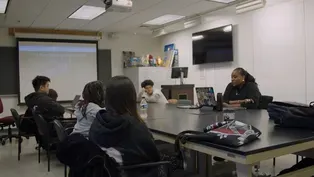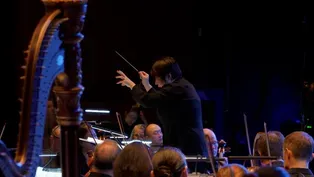State of the Arts
Batsto Homestead: Connecting to the Pine Barrens at Rowan University
Clip: Season 43 Episode 7 | 6m 16sVideo has Closed Captions
Art by Syd Carpenter and Jack Larimore evokes the Pinelands in Rowan's new Student Center.
At Rowan University, ceramic artist Syd Carpenter and sculptor Jack Larimore connect the campus to its Pine Barrens surroundings with “Batsto Homestead,” an evocative work of public art created for the new Student Center.
Problems with Closed Captions? Closed Captioning Feedback
Problems with Closed Captions? Closed Captioning Feedback
State of the Arts is a local public television program presented by NJ PBS
State of the Arts
Batsto Homestead: Connecting to the Pine Barrens at Rowan University
Clip: Season 43 Episode 7 | 6m 16sVideo has Closed Captions
At Rowan University, ceramic artist Syd Carpenter and sculptor Jack Larimore connect the campus to its Pine Barrens surroundings with “Batsto Homestead,” an evocative work of public art created for the new Student Center.
Problems with Closed Captions? Closed Captioning Feedback
How to Watch State of the Arts
State of the Arts is available to stream on pbs.org and the free PBS App, available on iPhone, Apple TV, Android TV, Android smartphones, Amazon Fire TV, Amazon Fire Tablet, Roku, Samsung Smart TV, and Vizio.
Providing Support for PBS.org
Learn Moreabout PBS online sponsorshipLarimore: Rowan University sits right at the edge of the Pine Barrens.
Students coming into Rowan are so close to this amazing thing, I don't think they all really sort of realize it's a very unique ecosystem.
Carpenter: And it has this distinct history to it.
Its so much had to do with making things.
It was preindustrial.
For me as an artist, it's an ideal source of content.
Narrator: Rowan University is right next to the New Jersey Pine Barrens, over a million acres of protected forest.
that's a unique part of the state's heritage.
Rowan's new student center building celebrates this legacy with Batsto Homestead, a public-art installation by renowned artists Syd Carpenter and Jack Larimore.
Salvante: The concept for the student center was the idea of a meeting place, a community place that was also inspired by our cultural and natural assets in our region.
Larimore: Syd and I loved the idea of responding to the space through the lens of the Pine Barrens.
But that was a stepping-off point.
[ Music plays ] Because the interplay of these things with this thing.
Narrator: The artists took the name Batsto from a village that's now restored as a historical site.
But their work refers broadly to the many villages of the Pinelands that are long gone.
With Batsto Homestead, they created a piece that pays homage to the natural world -- the trees and other vegetation of the Pines -- and to the people who live there.
Carpenter: You know, having that hat there, Larimore: Then the other piece of it was, what might we have that would talk about the culture?
And we decided that that would be artifacts.
And almost as if which happens in the Pine Barrens, you could be hiking along and just find the remnants of an old building.
Salvante: Syd tends to investigate the history of a community, and then that leads her into what objects and what kind of art she will then make from there.
Jack, to complement Syd's practice, he's motivated by the elements that he's encountering, and he lets the elements then inform him and direct him and motivate him forward in what he wants to do.
Carpenter: The magic of this is to find emblems that are evocative of place.
The hat itself is evocative of who might have worn the hat.
And then you look at it, "Well, that's a pretty distinctive hat.
Never saw one of those before."
But it has a certain sense of time about it.
Each object hopefully begins to get the viewer to ask some questions.
Going into the Pine Barrens, there were different plants that thrived in that environment, and cranberries were one of them.
As a sculptor, I get to play with the idea of clusters, or the notion of cranberry.
Narrator: Syd created her ceramic sculptures using South Jersey wild clay, which was hand-dug and processed by fellow ceramic artist Alan Willoughby and his team.
She then fired them inside Alan's traditional woodburning kiln.
Carpenter: We're wood-firing, which is what would have been occurring in the actual kilns in the Pine Barrens.
Every one of those kilns has its own fingerprint.
You're working with fire.
You're working with wood and ash and air -- things that play a part in what the final object looks like.
You take it out of the kiln, but you still don't know it.
What kind of gifts did the kiln provide for you?
Larimore: One of the interesting species in the Pine Barrens that would be good to call attention to would be the Atlantic white cedar.
That would really work within the space, 'cause they're very tall, vertical guys, you know?
So they can really reach up into this 50-, 60-foot-high space that they're gonna live within.
Narrator: Jack's Atlantic white cedars were harvested responsibly from an area where the changing habitat no longer supports them.
He stripped the trees of their branches and bark, but kept their magnificent height.
Larimore: Final part of the installation is just gonna be to bring these trees in and sort of slide them into their tree stands -- massive, steel tree stands much the way you would with a Christmas tree.
[ Music plays ] Salvante: Jack's work is very vertical.
It's majestic.
It directs your eye up to this beautiful, pinewood ceiling.
And, then, at the base, in the planters, you find Syd's ceramic sculptures.
They are fired in a way where they retain their clay color, earthy looking, almost bronze-like.
Larimore: There's an abstraction of a building we needed in order to give the artifacts a little bit of a place to be related to.
Salvante: It could have been a house.
It could have been a place of business.
It could have been a place of worship.
But in all of those types of buildings, there's community.
There are people coming together.
[ Music plays ] Carpenter: Anyone walking up to it can bring their own narrative to it.
So that means over time, as successions of students come to this place, the narrative continues to evolve depending upon who's standing in front of it.
Larimore: Any of those students within 20 minutes can actually get to the place that we're talking about and see what it was.
And so if we could just tickle that interest to go have that experience, you know, job well-done.
Deborah Jack: The Duality of Nature
Video has Closed Captions
Deborah Jack's alluring video installations explore coastlines affected by climate change. (8m 28s)
Video has Closed Captions
Nimbus Dance and New Jersey Symphony reimagine Stravinsky’s Firebird for today's world. (9m 25s)
Providing Support for PBS.org
Learn Moreabout PBS online sponsorshipSupport for PBS provided by:
State of the Arts is a local public television program presented by NJ PBS













